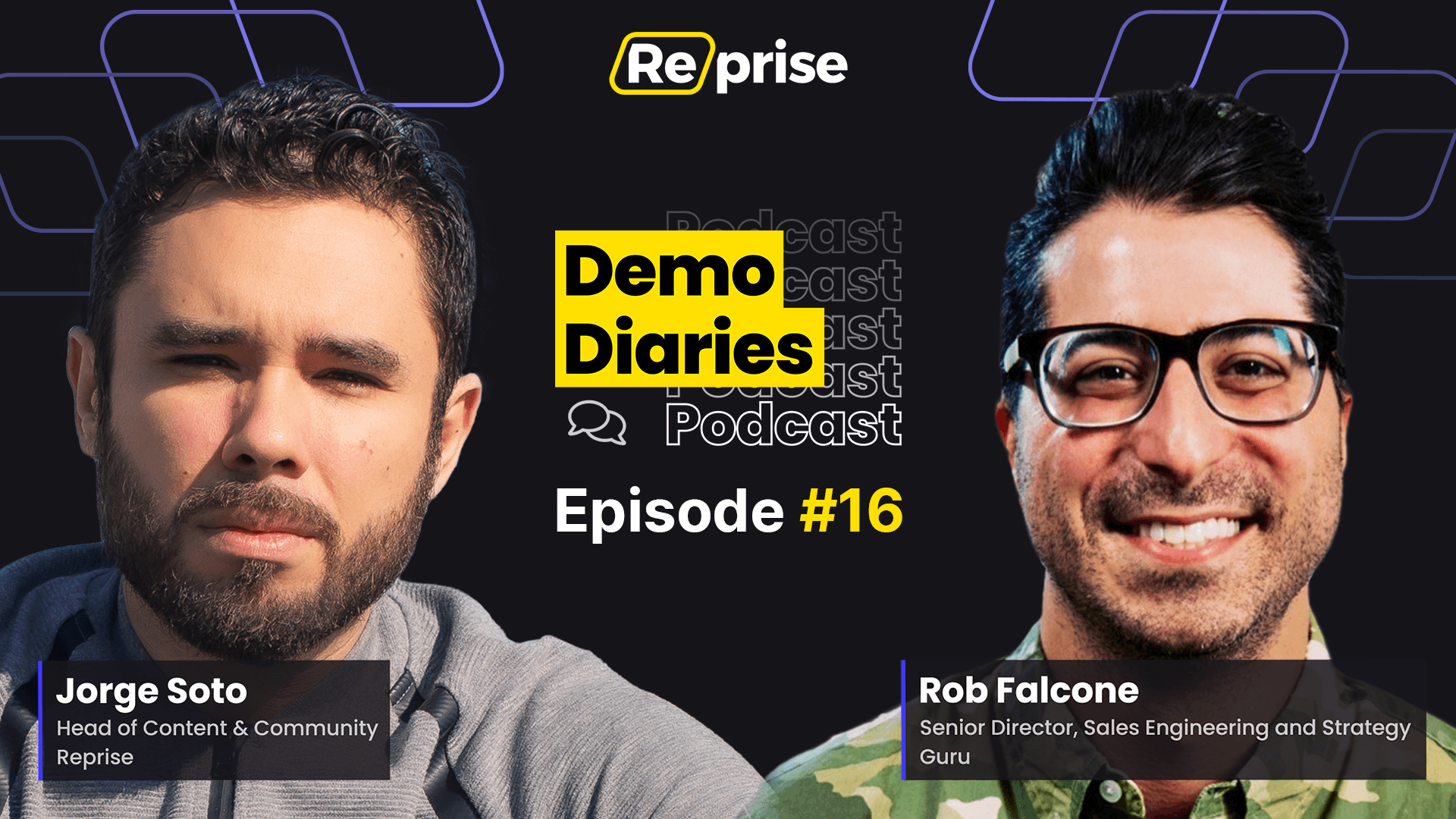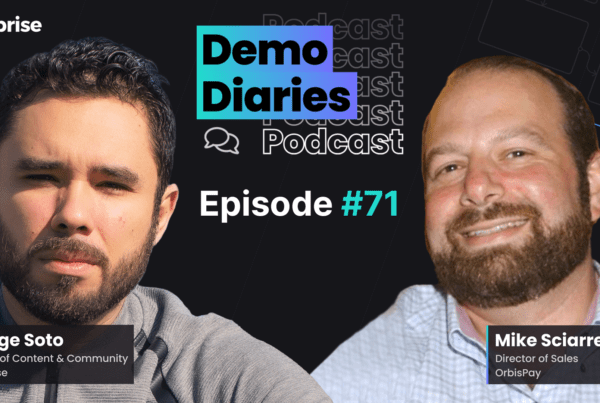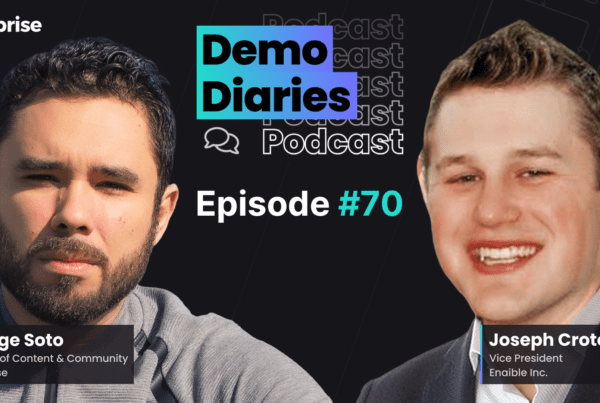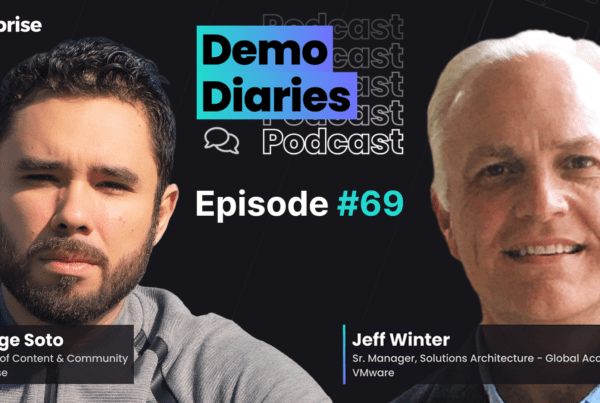The Demo Diaries podcast had a very special guest recently: top product-led sales expert and Author of Just F*ing Demo!, Rob Falcone. Rob is currently the Senior Director of Sales Engineering and Strategy at Guru. We had an interesting and insightful conversation about adding a product-led component to the mix for even traditional sales-led organizations, how to demo to win, and much more.
Meet Rob
He founded a startup company early in his career, and it failed as so many do; I can certainly relate. But it was an incredible experience and helped him decide the tech world was the right place to be. He started in client success, moved to sales engineering, and later became a sales rep and VP of sales before leading the product-led sales team at Guru.
His Book
Rob literally wrote the book on demos – Just F*ing Demo! came out in 2014, even though there was no product-led approach in SaaS at the time. Really the only way people could experience most products was through sales demos. Early in his career, he had a deliberate approach to what the sales team showed and didn’t, the hook to get the next meeting, what people thought and how the product fit in there.
But he also struggled early in his career to do effective sales demos and found there weren’t many good resources to help him improve, especially for SaaS. The book is very short, which people either love or hate, but focused and actionable. And it’s still relevant today.
Right now you can see the rise of product-led growth in new companies who are building their teams without a sales component to start, as they plan to layer humans in later. There are also companies going the other way – they have sales teams but see the value in adding a product-led component or experience because buyers these days have more control.
The sales team at Guru is really more of a combo sales/customer experience function that helps buyers onboard, adopt, and use the product. This new sales approach leans more on sales engineering than pure sales. What used to be called a technical win in the sales engineering world is now just how they win, and that’s more important than relationships and economics these days. Buyers want to know if you can meet their needs for a specific use case and that’s the most important detail.
Types of Demo in the Sales Motion
When Rob began his sales career, things were more linear. The typical sales motion had just one path for buyers to buy a product, and it was led by the sales team. Now buyers lead the process. If your product has a freemium option, prospects can be in there for months. For free trials, they can be focused on testing and trying certain things during the trial time.
And even if you don’t have any product-led components right now, buyers want it because that’s how they buy in their personal lives. It’s a more complex and different world than it was when Rob started in sales. But product-led certainly benefits the buyers, and companies who can meet those buyer expectations are the ones who will win.
5 Minute Discovery
Rob’s 5 Minute Discovery system started back in the sales-led world where you couldn’t or shouldn’t show everything in the demo – that’s a good way to overwhelm your prospects. And with most buyers these days, they don’t want to sit through 20 minutes of discovery before they even see the product. He decided to figure out what you can learn in 5 minutes to show a more relevant demo, and how to layer in convo points during the demo to get more information.
And now in the product-led world, 5 minutes of discovery will get you even more information. If you have a free trial or freemium, you already have some info on how they’re using it and what value they’re finding – and that’s a good jumping-off point for your conversation.
Ideal Demo Flow
Rob’s team does low-touch product consultations in 30 minutes at Guru. Buyers and prospects can sign up when they’re getting started or after using the product a while to brush up or solve a new problem. The buyer simply notes their use case and what they’re having trouble with, so the consult is really efficient. Their flow goes like this:
- 5 minutes for lateness and/or getting Zoom to work for everyone.
- 5 minutes for agenda setting and expectations for the call, as well as covering use cases and friction.
- 15 minutes for eliminating the friction that’s causing an issue. The sales team can share their screen and show the buyer, or the other way around. They also might share use cases and stories from other similar customers and how they made it work, or do a preemptive account upgrade for needed features if that solves the problem.
- 5 minutes of the next steps they can do on their own without needing to come back to the team.
- Then they follow up with an email listing saying those agreed-upon self-service steps, the date to do it, and a premade video that shows them how to do it, a customer story, or a link to the app.
In these short consults, they’re trying to do four things:
- Uncovering or confirming the buyer’s use case.
- Uncover or confirm what is the specific friction that’s keeping them from being successful with the product.
- Removing the friction in the most appropriate way.
- Guiding next steps towards things that matter to their business and they can execute on their own.
Shifting from Sales-Led to Product-Led
The most important thing Rob says is needed when moving towards a product-led model is being honest and realistic about what kinds of things users of your product can accomplish on their own, and what’s too big of a lift. It’s easy to just say, we’re product-led now, but not all products are built for self-serve.
Product-led is popular because it’s how people buy in real life now – they click a button and buy things and get their hands on it right away. Be realistic about this need and figure out one thing they can do on their own, like watch a very customized video on how to use the product or accomplish one small thing that will make them go down the sales-led path with you.
The more that companies can orient themselves toward this idea of making the customer successful without them, the more successful they’ll be. People just buy differently now than a decade ago.
Watch the full episode here:





